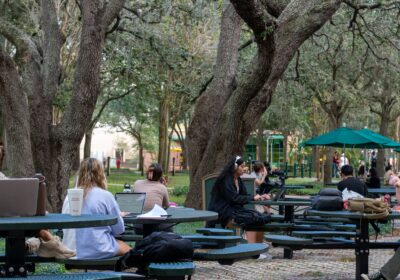Mystery monkey should remain free
The world-famous Mystery Monkey of Tampa Bay has haunted the tree-lined streets of the Bay area for the past few years, escaping many attempts at capture and capturing the imaginations of people everywhere.
He now appears to have settled down, living outside of a south Pinellas home and bonding with the couple that lives there. The Tampa Bay Times tracked down the infamous rhesus macaque, but wisely concealed his location in a recent article on the monkey’s new home.
Some naysayers argue that the monkey, who the couple calls “Mr. Monk,” is still a dangerous, wild animal. Though the species may not be native to the state, the Mystery Monkey has done nothing wrong and continues to embody the universal quest for freedom.
When told of Mr. Monk’s new living situation, Florida Fish and Wildlife Conservation Commission spokesman Gary Morse said to the Times, “This is dangerous and someone’s going to get seriously hurt, and it’s going to cause us to have to kill this animal on site. What they’re doing is they’re teaching him not to be cautious around people. In the end, it always ends badly.”
The couple, however, seems to be handling things cautiously, giving the monkey his space and not letting him in the house.
Morse’s dire prediction is reminiscent of Seminole trapper Vernon Yates, who said on a Miami radio show in 2010, “Yeah, wait until someone snaps a photo of the monkey eating a baby bald eagle. We’ll see how people feel then.”
Yates was referring to the widespread public support for the monkey and the belief that he should be kept free. This was during the height of the monkey’s fame, when Florida officials were spending thousand of dollars and even using helicopters on a wild monkey chase.
The monkey now has his own Facebook page with more than 82,000 fans, though from his status updates, the monkey now seems more concerned with advertising for a local nightlife website than the fight for freedom.
The monkey was even profiled on a National Geographic show last year called “Fugitive Animals.”
In 2010, the monkey was also featured on “The Colbert Report” as part of a semi-regular segment called, “Monkey on the Lam,” a testament to the strange fascination people have with escaped monkeys.
Host Stephen Colbert lampooned Yates for turning the monkey into a junkie after shooting him on several occasions with tranquilizer darts.
According to the Times, Yates no longer responds to calls about monkey sightings, and the Mystery Monkey seems to have kicked its habit and settled down for a quiet, domestic life. The couple sees Mr. Monk as being protective of them.
Defying all expectations, the monkey has remained free and healthy and has never hurt anyone. This is an amazing accomplishment for a wild animal on the loose in an urban area.
While Tampa certainly shouldn’t habitually let exotic animals run wild, the Mystery Monkey should remain an exception. It is that “mystery” that fascinates people. Though theories exist, no one knows for certain where he came from or why he stayed so long in an urban area. Much like Bigfoot and the Loch Ness Monster, Tampa’s mystery creature should remain elusive.
Michael Hardcastle is a senior majoring in creative writing.






